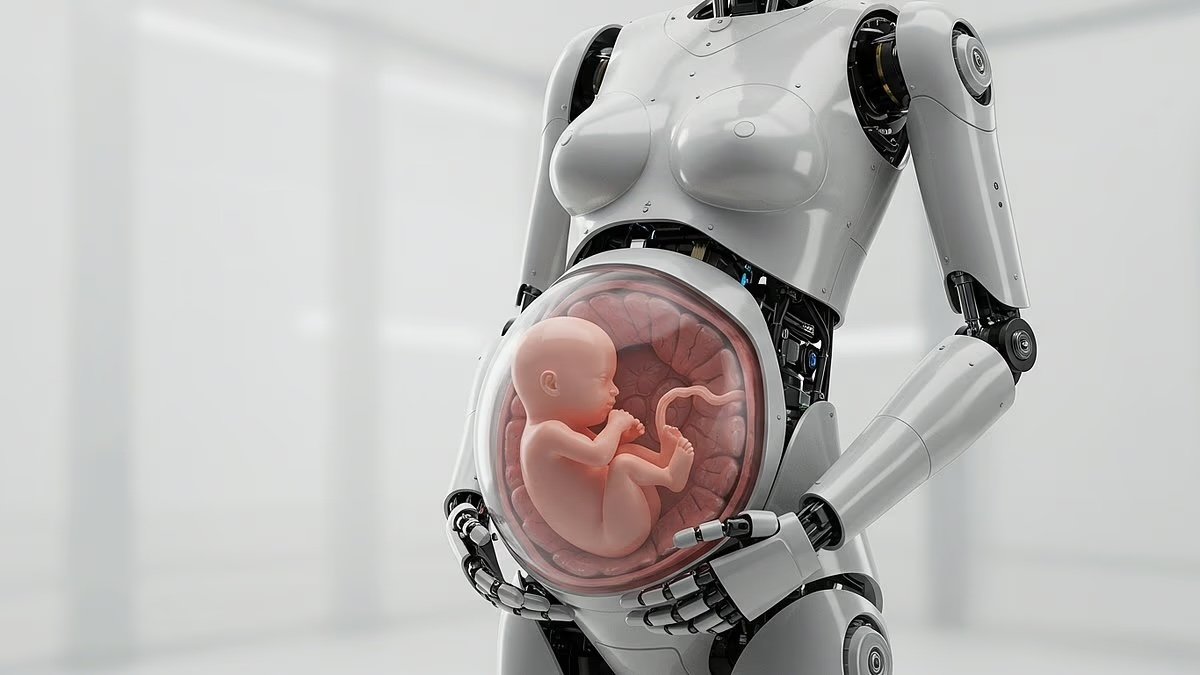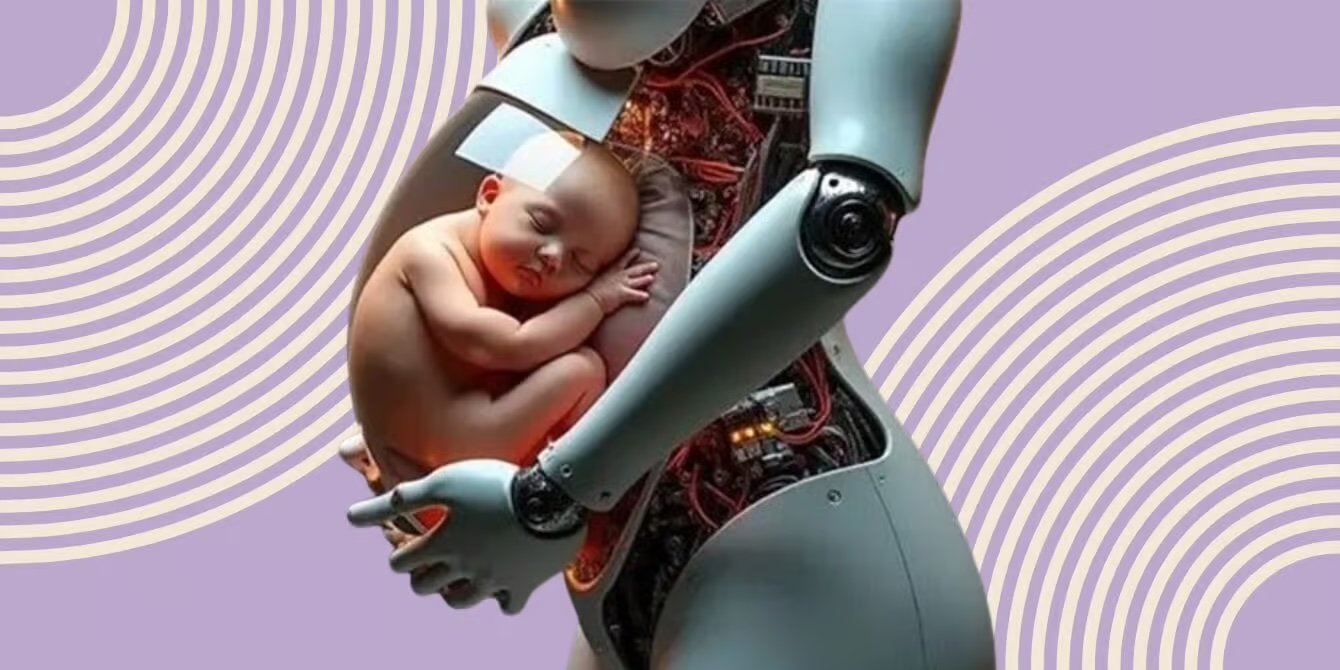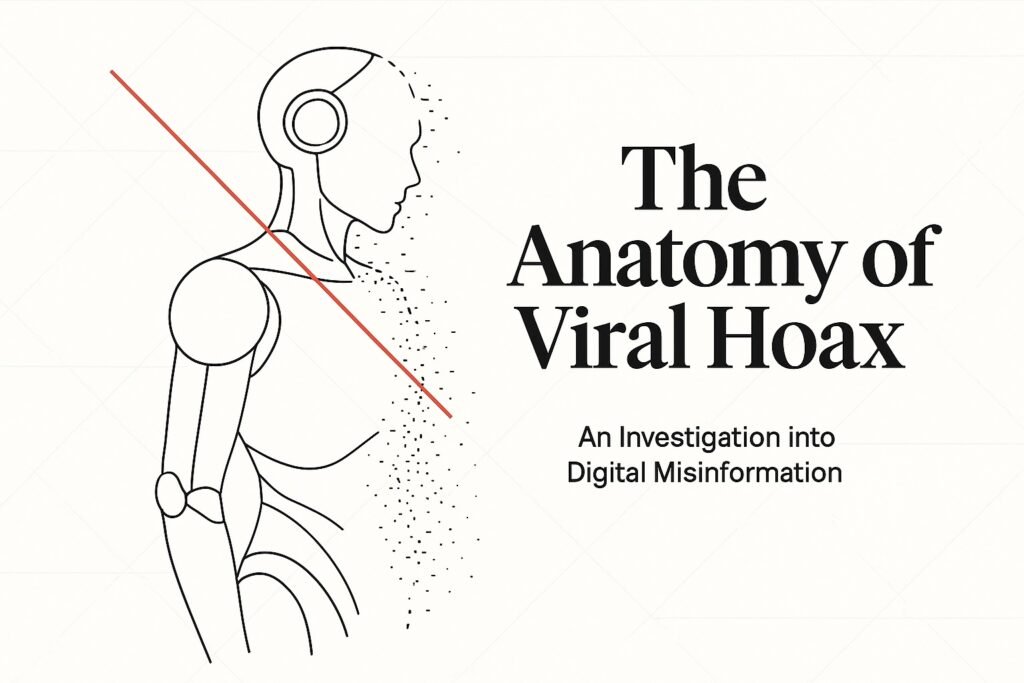The China pregnancy robot hoax swept the internet with claims about a revolutionary Chinese humanoid robot capable of carrying human pregnancies to full term. But when we investigated this China pregnancy robot story deeper, we uncovered a fascinating case study in how technological misinformation spreads through the digital ecosystem.
The Viral China Pregnancy Robot Hoax That Captivated the World
In August 2025, major news outlets including the New York Post, Times of India, and Economic Times reported on an extraordinary breakthrough: Kaiwa Technology, a Chinese company allegedly led by Dr. Zhang Qifeng from Nanyang Technological University, had announced a humanoid robot equipped with an artificial womb capable of sustaining complete human pregnancies.
The reported specifications seemed almost too good to be true. The robot would allegedly use a tube-based nutrition system in the abdominal area to nourish and grow a human fetus, offering an artificial alternative to traditional pregnancy. The estimated price was approximately 100,000 yuan (~$14,000 USD), significantly cheaper than traditional surrogacy costs ranging from $100,000-200,000 in the United States.
According to these viral reports, the prototype was announced at the World Robot Conference 2025 in Beijing, with a commercial launch planned for 2026. The story spread like wildfire across social media platforms, generating millions of views and sparking intense debates about the future of human reproduction.
Investigating the China Pregnancy Robot Claims: When Facts Don’t Add Up

However, when fact-checkers began investigating these extraordinary China pregnancy robot claims, a very different picture emerged. The reality behind this viral pregnancy robot story reveals important lessons about media literacy and the verification of scientific breakthroughs in our digital age.
China Pregnancy Robot Hoax: University Denies All Connections
Nanyang Technological University officially denied having any institutional connection with a “Dr. Zhang Qifeng” working on pregnancy robot projects. Snopes, the renowned fact-checking platform, classified the claim as false or unconfirmed after contacting the university directly. This represents a major red flag in the credibility of the entire story.
Missing Documentation for the Pregnancy Robot Claims
Despite claims of an announcement at the World Robot Conference 2025, which did indeed take place in Beijing from August 8-12, there is no official listing or public mention that Kaiwa Technology exhibited or announced any pregnancy robot at the event. The conference’s official website and exhibitor lists contain no reference to such a groundbreaking announcement.
Corporate Registry Contradictions
While Guangzhou Kaiwa Robot Technology Co., Ltd. does exist in Chinese corporate registries, the legal representative listed is Yue Dengfeng, not Zhang Qifeng as claimed in the viral articles. This discrepancy raises serious questions about the accuracy of the reporting and the identity of the alleged project leader.
Absence of Technical Evidence
Perhaps most tellingly, there are no technical demonstrations, patent filings, laboratory videos, or detailed specifications available for public review. For a project claiming to be near commercialization, the complete absence of technical documentation is highly unusual in the scientific community.
Real Artificial Womb Science vs China Pregnancy Robot Fiction

While the viral China pregnancy robot claims appear to be unfounded, genuine research into artificial womb technology does exist and represents one of the most fascinating frontiers in reproductive medicine. Understanding the current state of this science helps put the pregnancy robot hoax into proper perspective.
Current Scientific Achievements
The most significant breakthrough in artificial womb technology came in 2017 when researchers at Children’s Hospital of Philadelphia successfully maintained premature lamb fetuses in a fluid-filled “biobag” for up to four weeks. This groundbreaking study, published in Nature Communications, demonstrated the potential for extra-uterine support of fetal development.
However, it’s crucial to understand the limitations of this achievement. The biobag system supported partial extra-uterine development of already-formed fetuses, not complete gestation from conception to birth. The technology is designed primarily to help extremely premature babies survive and develop normally, rather than replace human pregnancy entirely.
Ethical and Regulatory Frameworks
The scientific community approaches artificial womb research with considerable caution due to complex ethical considerations. Most countries, including China, apply the “14-day rule” to human embryo research, limiting laboratory studies to the first two weeks of development. The implantation of genetically modified embryos for reproductive purposes remains prohibited in China, and surrogacy exists in a legal gray area.
Bioethicists and medical journals consistently emphasize that clinical trials on humans remain premature. The technology faces significant scientific, ethical, and regulatory hurdles before any real-world applications become possible. As noted in Scientific American, experts believe it’s still too early for clinical trials on artificial wombs, even for limited medical applications.
Timeline Reality Check
Leading experts in reproductive medicine suggest that even limited applications of artificial womb technology for premature infant care are still years away from clinical implementation. The idea of complete human gestation in an artificial system, particularly one housed in a humanoid robot, remains firmly in the realm of science fiction for the foreseeable future.
How the Pregnancy Robot Hoax Spread Through Digital Media
This China pregnancy robot case study reveals important patterns in how false scientific information propagates through modern media ecosystems. Understanding these mechanisms can help readers develop better media literacy skills when encountering future pregnancy robot hoax stories or similar technological misinformation.
The Echo Chamber Effect
The pregnancy robot story demonstrates how multiple publications can cite each other without returning to primary sources. Articles in major outlets referenced each other in a circular pattern, creating an illusion of multiple confirmations when, in reality, all reports traced back to unverified initial claims.
The Authority Trap in China Pregnancy Robot Claims
By invoking prestigious institutions like Nanyang Technological University and official-sounding conferences, the fake China pregnancy robot story borrowed credibility from legitimate sources. This technique makes false pregnancy robot claims more believable to casual readers who don’t verify the specific connections claimed.
Visual Misinformation
Many of the viral articles featured images that appeared to show futuristic robots or laboratory equipment. However, these images were either stock photos, concept art, or AI-generated visuals that had no connection to actual working prototypes.
Global Context: China and Technological Expectations
The viral spread of this story also reflects broader geopolitical dynamics and expectations about technological innovation coming from China. International media often anticipate dramatic technological breakthroughs from Chinese companies, creating fertile ground for unverified claims to gain traction.
This expectation can lead to reduced scrutiny of extraordinary claims, particularly when they involve emerging technologies where the general public has limited scientific knowledge. The result is a perfect storm for misinformation that combines technological complexity with geopolitical intrigue. This phenomenon isn’t unique to reproductive technology – we’ve seen similar patterns in AI breakthroughs and genetic engineering advances where hype often precedes scientific reality.
Lessons for Media Consumers
The pregnancy robot hoax offers valuable lessons for navigating information in the digital age. Here are key strategies for evaluating scientific claims:
Verify Primary Sources
Always look for original research papers, official company announcements, or direct statements from named researchers. Be skeptical of claims that only appear in secondary media reports without clear attribution to primary sources.
Check Institutional Affiliations
When scientists or researchers are quoted, verify their actual affiliations with claimed institutions. A quick search of university faculty directories can often confirm or debunk alleged connections.
Look for Technical Details
Legitimate scientific breakthroughs typically include detailed explanations of methodology, limitations, and future research directions. Vague descriptions or missing technical specifications should raise red flags.
Consider the Timeline
Be skeptical of claims about imminent commercialization of revolutionary technologies, especially in highly regulated fields like medicine. Real scientific progress typically follows longer, more gradual timelines.
The Future of Reproductive Technology
While the viral pregnancy robot story was false, legitimate research into reproductive assistance continues to advance. Scientists are making genuine progress in understanding fetal development, improving outcomes for premature births, and developing new fertility treatments.
The real future of reproductive technology likely involves incremental improvements to existing methods rather than revolutionary replacements for human pregnancy. These advances will come through rigorous research, extensive testing, and careful ethical consideration rather than dramatic announcements at technology conferences. Looking ahead, experts predict that by 2030, we’ll see more realistic advances in biotechnology and medical innovation that will genuinely benefit human health and reproduction.
Conclusion: Truth in the Age of Viral Content
The China pregnancy robot story serves as a powerful reminder that in our interconnected digital world, extraordinary claims require extraordinary evidence. While the pace of technological advancement continues to accelerate, our critical thinking skills must evolve to match.
The real tragedy of such misinformation isn’t just the spread of false facts, but the potential erosion of public trust in legitimate scientific research. When fictional breakthroughs go viral, they can overshadow genuine scientific progress and make the public more skeptical of real innovations.
As consumers of information, we have a responsibility to verify claims before sharing them, especially when they seem too remarkable to be true. The most fascinating aspects of real science don’t need fictional embellishment to be compelling.
The next time you encounter a breathtaking technological breakthrough online, take a moment to investigate the sources. You might discover that reality, while perhaps less sensational than fiction, is ultimately far more fascinating and deserving of our attention.
Tools We Use for Research and Content Creation
In our mission to bring you accurate, well-researched content and debunk misinformation, we rely on several tools that help us work more effectively:
Online Privacy and Security: When conducting investigative research like this article, protecting our digital footprint is crucial. We use Surfshark VPN to ensure secure browsing while accessing international sources and databases. This is especially important when investigating controversial topics or accessing region-restricted academic resources.
Video Content Creation: To make complex scientific topics accessible to broader audiences, we create educational videos using Pictory AI. This tool helps us transform written research into engaging visual content, making fact-checking and scientific education more digestible for our community.
Newsletter Management: Staying connected with our readers who value accurate science communication is essential. We use Beehiiv to manage our newsletter, ensuring subscribers receive timely updates about scientific breakthroughs, myth-busting articles, and media literacy tips directly in their inbox.
These tools enable us to maintain high standards of research integrity while effectively sharing important information about distinguishing scientific fact from fiction.
